
HMS Liverpool was a Type 42 destroyer of the Royal Navy. She was built by Cammell Laird in Birkenhead and launched on 25 September 1980 by Lady Strathcona, wife of Euan Howard, the then Minister of State for Defence. Liverpool was the last Type 42 Batch 2 in service.

HMS Montrose was the eighth of the sixteen-ship Type 23 or Duke class of frigates, of the Royal Navy, named after the Duke of Montrose. She was laid down in November 1989 by Yarrow Shipbuilders on the Clyde, and was launched on 31 July 1992 by Edith Rifkind, wife of Malcolm Rifkind, Secretary of State for Defence. She was commissioned into service in June 1994.

The third HMS Argyll is a Type 23 Duke-class frigate. Commissioned in 1991 and prior to her retirement, Argyll was the oldest serving Type 23 frigate in the Royal Navy. Like all of her class she was named after a British dukedom, in this case that of Argyll. HMS Argyll was laid down in March 1987 by Yarrow Shipbuilders at Glasgow, and launched in 1989 by Lady Wendy Levene, sponsored by the Worshipful Company of Paviors.

HMS Lancaster is a Duke-class Type 23 frigate of the Royal Navy, launched by Queen Elizabeth II on 24 May 1990. The ship is known as "The Queen's Frigate", the Duke of Lancaster being a subsidiary title of the Sovereign. Being the third ship in the Type 23 class, Lancaster was originally allocated the pennant number F232 until it was noted that the 232 is the Royal Navy report form for groundings and collisions and therefore considered unlucky. She is one of the few ships left in the fleet with some female officers but mess decks which are men-only.

HMS Iron Duke is a Type 23 frigate of the Royal Navy, and the third ship to bear the name.

HMS Northumberland is a Type 23 frigate of the Royal Navy. She is named after the Duke of Northumberland. She is the eighth RN ship to bear the name since the first 70-gun ship of the line in 1679, and the ninth in the class of Type 23 frigates. She is based at Devonport and is part of the Devonport Flotilla.
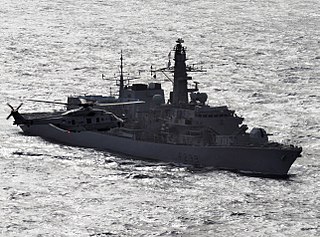
HMS Richmond is a Type 23 frigate of the Royal Navy. She was launched on 6 April 1993 by Lady Hill-Norton, wife of the late Admiral of the Fleet The Lord Hill-Norton, and was the last warship to be built by Swan Hunter Shipbuilders. She sailed from the builders on the River Tyne in November 1994. She is named for the Dukedom of Richmond.
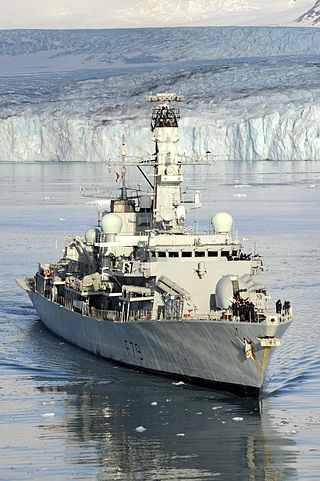
HMS Portland is a Type 23 frigate of the British Royal Navy. She is the eighth ship to bear the name and is the fifteenth and penultimate ship of the 'Duke' class of frigates, and is named for the currently extinct title of the Dukedom of Portland, and more particularly for the third Duke, who was Prime Minister.
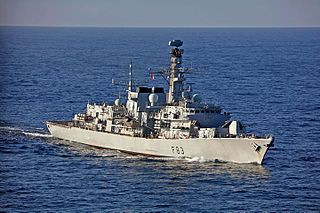
HMS St Albans is a Type 23 frigate of the Royal Navy. She is the sixth ship to bear the name and is the sixteenth and final ship in the Duke class of frigates. She is based in Devonport, Plymouth.
HMS Gloucester was a Batch 3 Type 42 destroyer of the Royal Navy, built by Vosper Thorneycroft at Woolston, Southampton and launched on 2 November 1982 by The Duchess of Gloucester. Gloucester was one of the modified last four of the class to be built, having a lengthened hull design giving better seakeeping qualities, greater endurance and an external 'strake' to counter longitudinal cracking, seen on earlier ships of the type.
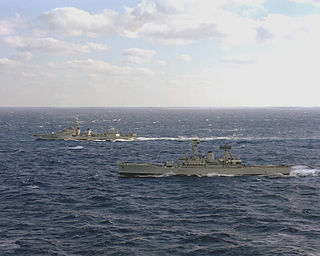
HMS Scylla (F71) was a Leander-class frigate of the Royal Navy (RN). She was built at Devonport Royal Dockyard, the last RN frigate to be built there as of 2016. Scylla was commissioned in 1970, taken out of service in 1993 in accordance with Options for Change, and sunk as an artificial reef in 2004 off Whitsand Bay, Cornwall.

HMS Argonaut (F56) was a Leander-class frigate that served with the Royal Navy from 1967 to 1993. She took part in the Falklands War in 1982, sustaining damage and casualties in action.

HMS Achilles was a Leander-class frigate of the Royal Navy. She was built by Yarrow at Glasgow. She was launched on 21 November 1968 and commissioned on 9 July 1970. She was sold to Chile in 1991 and served in the Chilean Navy as Ministro Zenteno. She was washed away from her berth at Talcahuano by a tsunami following the February 2010 Chile earthquake, and ran aground on the coast a few kilometres to the north. She was scuttled the following month by the Chilean Navy as a danger to navigation.
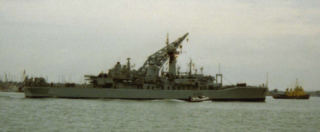
HMS Sirius (F40) was a Leander-class frigate of the Royal Navy (RN) built by H.M. Dockyard Portsmouth, and was the penultimate RN warship to be built there for a period of forty years, until Vosper Thornycroft built HMS Clyde. Sirius was launched on 22 September 1964 and commissioned on 15 June 1966. The ship continued in front line service until February 1992.
HMS Phoebe (F42) was a Leander-class frigate of the Royal Navy (RN). She was, like the rest of her class, named after a figure of mythology. Built by Alexander Stephen and Sons on the River Clyde, she was launched on 19 December 1964 and commissioned on 15 May 1966.

HMS Mohawk was a Tribal-class frigate of the Royal Navy in service from 1963. She was named after a tribe of Native Americans located in southeast Canada and New York State. Mohawk was scrapped in 1983.

Standing Royal Navy deployments is a list of operations and commitments undertaken by the United Kingdom's Royal Navy on a worldwide basis. The following list details these commitments and deployments sorted by region and in alphabetical order. Routine deployments made by the Navy's nuclear-powered submarines and their location of operations is classified.

HMS Dauntless is the second ship of the Type 45 or Daring-class air-defence destroyers built for the British Royal Navy. She was launched at Govan in January 2007, was handed over to the Royal Navy on 3 December 2009 and was formally commissioned on 3 June 2010.

HMS Puncher is an Archer-class patrol vessel of the Royal Navy. She is permanently based at HMNB Portsmouth and forms part of the First Patrol Boat Squadron (1PBS). Puncher is primarily tasked with training the officer cadets and midshipmen of the University of London's University Royal Naval Unit. She also provides a training platform for young officers undertaking training during the Royal Navy's initial warfare officers' course, and has also been used in the coastal protection role, most notably during Operation Olympic, the security operation surrounding the London 2012 Olympic Games.

HMS Loch Fyne was a Loch-class frigate of the British Royal Navy, built by the Burntisland Shipbuilding Company Ltd, Burntisland, Fife, Scotland, and named after Loch Fyne in Scotland. The ship was launched in 1944, and served at the end of World War II. Recommissioned in 1951, she served in the Persian Gulf and was scrapped in 1970.

















